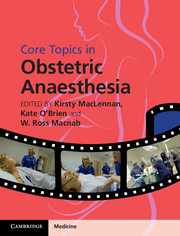Book contents
- Frontmatter
- Contents
- List of contributors
- Preface
- Section 1 Basic science, epidemiology and service organization
- Section 2 Obstetric aspects
- Section 3 Provision of anaesthesia
- Section 4 Medical conditions in pregnancy
- Section 5 Postpartum complications and obstetric emergencies
- 25 Maternal collapse, including massive obstetric haemorrhage, amniotic fluid embolism and cardiac arrest
- 26 Postpartum complications, follow-up and maternal satisfaction
- Section 6 Service organization
- Index
- Plate section
- References
26 - Postpartum complications, follow-up and maternal satisfaction
from Section 5 - Postpartum complications and obstetric emergencies
Published online by Cambridge University Press: 05 December 2015
- Frontmatter
- Contents
- List of contributors
- Preface
- Section 1 Basic science, epidemiology and service organization
- Section 2 Obstetric aspects
- Section 3 Provision of anaesthesia
- Section 4 Medical conditions in pregnancy
- Section 5 Postpartum complications and obstetric emergencies
- 25 Maternal collapse, including massive obstetric haemorrhage, amniotic fluid embolism and cardiac arrest
- 26 Postpartum complications, follow-up and maternal satisfaction
- Section 6 Service organization
- Index
- Plate section
- References
Summary
Introduction
Over the last three decades, the use of regional anaesthesia has led to a significant decrease in maternal morbidity and mortality. However, obstetric anaesthesia remains one of the leading causes of litigation in anaesthesia in the UK. All anaesthetic techniques carry a risk of complication and potential patient harm. Although complications cannot be entirely eliminated, risks can be reduced with a combination of:
• Appropriate training and supervision
• Meticulous technique
• Reliable follow-up with vigilance for complications
• Sound multidisciplinary communication
• Regular audit.
Post dural puncture headache (PDPH)
PDPH is one of the most common complications encountered following neuraxial anaesthesia in obstetrics. A tear in the dura leads to leakage of cerebrospinal fluid (CSF), which results in reduction in intracranial pressure and a downward traction on pain-sensitive intracranial structures, including meninges, veins and cranial nerves. Following CSF loss, compensatory vasodilatation occurs, which further exacerbates symptoms.
In parturients receiving epidural anaesthesia, the incidence of accidental dural puncture (ADP) is between 0 and 2.6%. The incidence of PDPH varies: up to 80% of women will have a headache after an ADP following a labour epidural with a 16G Tuohy needle, 0–5% following spinal anaesthesia with a 25G Whitacre needle, whilst a tertiary unit reported an incidence of 0.5% following 16,000 combined spinal epidurals (CSE).
In addition to the size and type of needle, the incidence of ADP is inversely proportional to the experience of the person performing the procedure and directly proportional to the number of attempts at needle insertion. In almost 30% of patients, ADP is not recognized at the time of epidural needle placement, suggesting that the epidural catheter is responsible.
PDPH is classically described as an occipitofrontal headache, often radiating to the neck and shoulders with postural features (exacerbated by sitting, standing, coughing and straining, and alleviated by lying flat). A majority (90%) of patients will report symptoms within 72 hours post puncture, although both immediate and later presentations have been described. Other features of PDPH include: nausea, vomiting, neck stiffness, tinnitus and visual disturbances. Rarely, cranial nerve palsies, convulsions or subdural haematomas have been reported as a result of PDPH. Criteria for PDPH have been described by The International Classification of Headache Disorders (ICHD) and are summarized in Table 26.1.
- Type
- Chapter
- Information
- Core Topics in Obstetric Anaesthesia , pp. 201 - 210Publisher: Cambridge University PressPrint publication year: 2015



